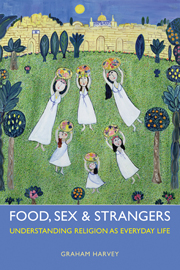Book contents
- Frontmatter
- Dedication
- Contents
- Preface
- 1 Of god and goats
- 2 Religioning elsewhere
- 3 Christianity is not a religion
- 4 Talking like a pirate
- 5 Real world
- 6 Doing violence with impunity
- 7 Respecting relations
- 8 Things full of meaning
- 9 Purity and pilgrimages
- 10 Enchantment and emplacement
- 11 Christians do religion like other people
- 12 Religion is etiquette in the real world
- Bubliography
- Index
6 - Doing violence with impunity
- Frontmatter
- Dedication
- Contents
- Preface
- 1 Of god and goats
- 2 Religioning elsewhere
- 3 Christianity is not a religion
- 4 Talking like a pirate
- 5 Real world
- 6 Doing violence with impunity
- 7 Respecting relations
- 8 Things full of meaning
- 9 Purity and pilgrimages
- 10 Enchantment and emplacement
- 11 Christians do religion like other people
- 12 Religion is etiquette in the real world
- Bubliography
- Index
Summary
Religious activity among Ngati Uepohatu has a purpose that struck me as surprising or even shocking when I first read Te Pakaka Tawhai's introduction to “Maori Religion” (Tawhai [1988] 2002). It became the major inspiration for this book when I found myself wondering whether Tawhai's statement that “the purpose of religious activity here is to … do violence with impunity” (ibid.: 244) applies to religious activities elsewhere. Perhaps it may even be true of religious activities everywhere. The entirety of Tawhai's article deserves a place in a shortlist of excellent discussions of religions. It exemplifies careful reflexivity, respectful engagement and clear analysis of data. It offers correctives to the ways religions are sometimes studied and written about. But, most significantly for the question of how religion might be defined, Tawhai's article takes us far from the Protestant and Enlightenment rooted treatment of religion as believing of hyperseparated individuals in transcendent deities. Instead, it attends to the performance of religion by relational persons in a participatory, material world.
TREES AND TUBERS
Tawhai illustrates his claim that (to cite the full phrase) “the purpose of religious activity here is to seek to enter the domain of the superbeing and do violence with impunity” by saying that this means “to enter the forest and do some milling for building purposes, to husband the plant and then to dig up the tubers to feed one's guests” (Tawhai [1988] 2002: 244). People in and around Ruatoria, near Aotearoa's East Cape, do not all engage in forestry or gardening.
- Type
- Chapter
- Information
- Food, Sex and StrangersUnderstanding Religion as Everyday Life, pp. 99 - 116Publisher: Acumen PublishingPrint publication year: 2013



